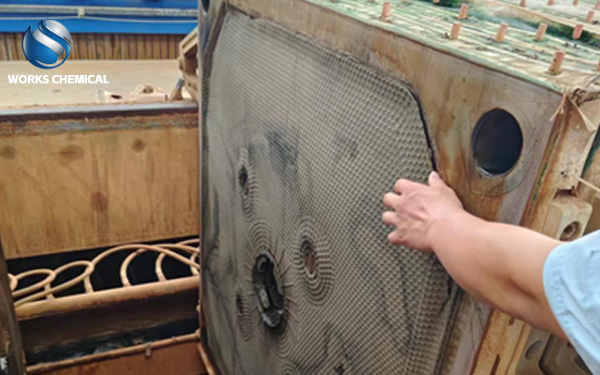
During the sludge treatment process with a plate and frame filter press, the addition of specific chemicals can significantly improve the sludge dewatering performance, thereby reducing the moisture content of the mud cake. The following are the chemical agent selection schemes and technical key points for different sludge types and treatment requirements:

I. Core Agent Types and Mechanism of Action
Flocculant (core agent)
Cationic polyacrylamide (CPAM)
Function: Through charge neutralization and bridging adsorption, sludge particles are flocculated into large particles, forming a loose and porous flocs structure, which facilitates water release.
Effect: It can reduce the moisture content of the mud cake by 5% to 10%, and the dosage is generally 0.1% to 0.5% of the dry sludge volume.
Applicable scenarios: Municipal sludge, papermaking sludge and other sludges with high organic matter content.
Anionic Polyacrylamide (APAM
Function: It is suitable for positively charged sludge particles (such as inorganic sludge), promoting flocculation through adsorption bridging.
Note: It should be used in combination with coagulants (such as polyaluminium chloride), and its effect is limited when used alone.
Two. Coagulant (Auxiliary agent)
Polyaluminium chloride (PAC)/Polymeric ferric sulfate (PFS)
Function: To disrupt the colloidal stability of sludge, compress the double electric layer, and destabilize sludge particles.
Effect: When used in combination with PAM, it can increase the dewatering efficiency by 20% to 30%, especially suitable for sludge with high suspended solids.
The addition sequence: Add the coagulant first, then the flocculant. The interval time needs to be determined through small-scale tests.
Three. Cell wall disruptor (for activated sludge)
Surfactant/enzyme preparation
Function: Break through the cell walls of microorganisms and release intracellular bound water (accounting for 60%-70% of the total water volume of activated sludge).
Effect: The moisture content of the mud cake can be further reduced by 3% to 5%, and it is often used in combination with compound agents (such as sludge enhancers).
Four. Framework Builder (Enhancing the permeability of the filter cake)
Modified diatomite/bentonite
Function: To form a rigid framework in the sludge, prevent the filter cake from being overly compacted under high pressure, and keep the water filtration channels unobstructed.
Effect: The plate and frame filtration cycle is shortened by 30% to 50%, and the clarity of the filtrate is improved.
Ii. Compound Chemical Solution: Sludge Enhancer (Innovative Technology)
Sludge enhancers achieve efficient dewatering through a "triple mechanism of action" :
Composite flocculation: Cationic PAM and high-molecular polymers work in synergy to rapidly form large particle flocs.
Cell wall disruption: Surfactants penetrate the cell membrane and release bound water.
Skeleton support: Modified inorganic materials are used to construct the water filtration channels to prevent the filter cake from clogging.
Application effect:
The moisture content of the mud cake can be reduced from over 80% to below 60% (municipal sludge).
The processing efficiency of the plate and frame filter press has been increased by 40%, and the dosage of chemicals has been reduced by 30% to 50%.
The calorific value of sludge is increased by 15%, which is convenient for subsequent incineration or resource utilization.
Iii. Key Principles for Selecting Chemicals
Sludge property matching
Organic sludge (such as municipal sludge) : Cationic PAM+ cell wall breaker is preferred.
Inorganic sludge (such as sand and gravel sludge) : anionic PAM+ coagulant.
Oily sludge: Emulsifiers need to be added to break the emulsion before flocculation.
Deal with goal orientation
Rapid dehydration: Select high-molecular-weight PAM (molecular weight >12 million).
Deep dewatering: Compound agents (such as sludge enhancers) + skeleton materials.
Resource utilization: Avoid the use of chemicals such as lime that affect calorific value.
A balance between economy and environmental protection
Give priority to choosing chemicals with low unit processing costs, no corrosiveness and no secondary pollution.
Although the unit price of compound chemicals is high, the comprehensive cost (chemicals + energy consumption + disposal fee) can be reduced by 20% to 30%.
Iv. Implementation Steps and Precautions
Conduct a small-scale test to determine the formula
The sludge from the site was taken for beaker tests to measure the sedimentation rate, SS of the filtrate and the moisture content of the sludge cake under different combinations of chemicals.
Typical test process: Adjust pH→ Add coagulant → Stir → Add flocculant → stir → sedimentation → Filter.
The pilot-scale test verifies the effect
Continuous tests were conducted on the plate and frame filter press, and parameters such as feed pressure, filtrate flow rate, and mud cake thickness were recorded.
Optimize the dosing points of chemicals (such as the inlet of the sludge pump or the feed pipe of the filter press).
Operation monitoring and adjustment
Regularly test the moisture content of the mud cake (it is recommended that it be ≤60% to meet the standard).
The chemical formula is dynamically adjusted according to the fluctuations in the properties of the sludge (such as changes in moisture content and organic matter content).
Conclusion
Selecting the appropriate chemicals is the core for plate and frame filter presses to reduce the moisture content of the mud cake. For general demands, the combination of PAC and PAM can meet the basic requirements. If deep dewatering, resource utilization or treatment of difficult-to-dewater sludge (such as activated sludge) is pursued, compound agents such as sludge enhancers are a better choice. It is suggested that the optimal scheme be determined through small-scale and pilot-scale tests, and a dynamic matching mechanism of sludge properties - chemical formula - operation parameters be established to achieve dual benefits of economy and environmental protection.